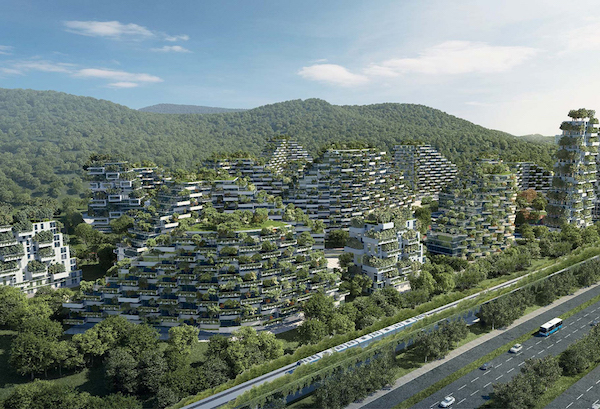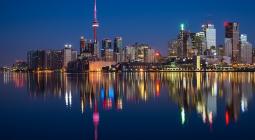Grow your own city – vertical forests take off.

Milan’s Il Bosco Verticale (the Vertical Forest) is a high rise building populated by people and trees. It is the first of a new concept of building in cities being pioneered by Stefano Boeri’s architectural practice based in Milan. Although only a few years old, he is now planning entire city neighbourhoods around the concept.
The Milan project consists of two towers in the centre of the city, on the edge of the Isola neighbourhood, of 80m2 and 112m2, planted with 800 trees (each measuring 3, 6 or 9 metres), 4500 shrubs and 15,000 plants from a wide range of shrubs and floral plants distributed according to the sun exposure of the facade.
By using the walls it provides the equivalent greenery over an urban surface area of 1500m², of 20,000m² of forest and undergrowth.
It therefore contributes to the regeneration of the urban environment and biodiversity without expanding the territory of the city and creates a microclimate that produces humidity, absorbs CO2, noise and dust particles and produces oxygen.
The $89.5 million towers, completed in 2014, have won several awards including the RIBA Award for International Excellence 2018 and replaced an old industrial building once occupied by artists –who were moved to a nearby “Art Incubator”.
Botanical buildings
It was not a simple project. A team of botanists helped the architect Stefano Boeri to choose the types of trees and select their positioning on the facades and by height, a process that took two years.
Management of the tree pots is covered by building regulation. Understandably, the building attracts birds and insects.
The plants were grown specifically for the purpose, allowing them to acclimatise to the conditions they would experience on the building.
The design took into account the water needs freely gave other plants depending upon where they were positioned.
Management of the tree pots is covered by building regulation. Understandably, the building attracts birds and insects.
A growing concept
Now the architect has revealed plans for similar vertical forest buildings in European cities including Treviso in Italy, Lausanne in Switzerland and Utrecht in the Netherlands.
Another, in Nanjing, China (see below), was completed last year.

He has also designed an entire “forest city”, scheduled for completion in 2020, in the Chinese city of Liuzhou, in the mountainous Guangxi province.
It consists of tree-covered houses, hospitals, schools and office blocks over a 15 million square-foot site – a proper regenerative city.
A “forest city” in China will host more than 30,000 inhabitants. When mature it will be nearly impossible to distinguish the urban centre from the green area surrounding it.
When complete, it will host more than 30,000 inhabitants. When mature it will be nearly impossible to distinguish the urban centre from the green area surrounding it.
This could be really important to China, where 14 million inhabitants migrate each year to cities.

Renewable energy
Geothermal energy will be used for temperature regulation inside the buildings and an integrated solar panel system will be installed on the roofs. An electric train railway will take residents to the city centre.
Around 40,000 trees and about 1 million plants of more than 100 different species will be planted in streets and buildings.
The vegetation will improve air quality by absorbing 57 tonnes of carbon dioxide and particulate matter, and producing 900 tonnes of oxygen every year, as well reducing average temperatures and noise.
The principles fundamental to Boeri’s approach include avoiding the unrestrained use of cement, blocking the expansion of cities by enclosing them in forests, safeguarding forests and biodiversity within cities to reduce pollution and making nature an essential component of architecture.
Cities produce nearly 70 per cent of carbon dioxide emissions…”Bringing forests within cities, or creating forest cities means fighting the enemy on its turf, and transforming carbon dioxide into a fertiliser to feed plants”.
“Cities produce nearly 70 per cent of carbon dioxide emissions, the cause behind phenomena such as the greenhouse effect, the melting of ice caps and sea level rise, whilst forests and oceans are the main enemies of CO2, absorbing approximately 35 per cent of the amount emitted,” Boeri says.
“Bringing forests within cities, or creating forest cities means fighting the enemy on its turf, and transforming carbon dioxide into a fertiliser to feed plants”.
Yibo Xu, China partner and principal architect at Stefano Boeri Architetti, told a conference in Hong Kong last December that more stakeholders in China are realising the value of integrating green elements into urban architecture and the benefits that these projects can bring to the city.

“This is something that everyone agrees on – clients, investors, governments, and citizens.”
Xu said the firm has been commissioned for another project in Wuhan by a wealthy property developer.
David Thorpe is the author of the books The ‘One Planet’ Life and the new ‘One Planet’ Cities.
14 May 2019







